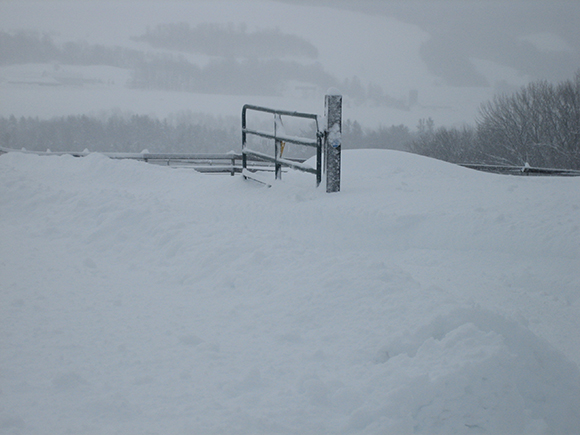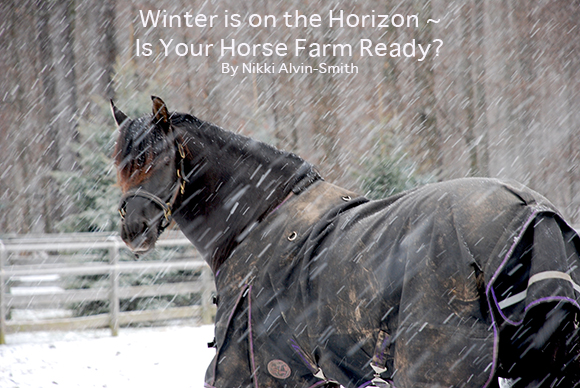Winter is on the Horizon ~ Is Your Horse Farm Ready?
By Nikki Alvin-Smith
The sun is shining but there is already a dusting of snow on the ground here in New York, with a three-inch snowfall expected tonight. Hopefully you’ve already thought about the cold weather coming and have prepared your barn in advance of its arrival. If you are in the process of purchasing a new barn or developing a farm property, there are a few things you might want to think about to make winter more pleasant for yourself and your horses. Here are a few tips on how to make your farm winter friendly.
Mud Mayhem
All high traffic areas of your barn or run-in shed should have some extra help to keep them mud free in poor weather. This may involve laying in some drainage, adding gravel and then placing stone dust down on top, to form an almost concrete floor finish, or you may want to pour concrete in aisleways and entranceways.
At our farm we went with crusher run, a screened gravel mixture and topped it with stone dust, and then ran heavy duty rubber mats over the entire aisleway. The rubber is super comfortable for bending down and wrapping horses legs, picking feet and grooming. It is easy to vacuum or sweep up any mess and good housekeeping is an important part of fire safety. Additionally the non-slip surface is safer for our horses than concrete. When you are on your feet all day the rubber mats add a nice comfort layer that you and your medical care professionals and farrier, will much appreciate.
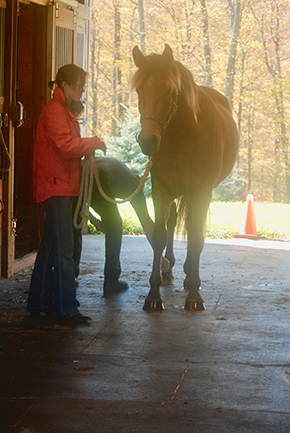 We added rubber mats across the entire floor, not just through the center. The reason being we had our daughter’s horse at a trainer’s yard many years ago and returned home from competing in Florida to find his front leg the size of a stove pipe. He had apparently slipped on the concrete coming out of the stall and everyone had failed to notice the injury. There was a sharp left hand turn from the stall door and then a sharp right turn around the corner through to the exit door that was required for turnout. This errant slip resulted in a 25 percent tear to his front suspensory ligament.
We added rubber mats across the entire floor, not just through the center. The reason being we had our daughter’s horse at a trainer’s yard many years ago and returned home from competing in Florida to find his front leg the size of a stove pipe. He had apparently slipped on the concrete coming out of the stall and everyone had failed to notice the injury. There was a sharp left hand turn from the stall door and then a sharp right turn around the corner through to the exit door that was required for turnout. This errant slip resulted in a 25 percent tear to his front suspensory ligament.
To cope with mud through gateways and in the front of the run-in sheds we also lay in drainage where necessary (French drains work well and are inexpensive) and then put down Crusher Run topped with stone dust. This keeps these areas mud free makes it safer for turnout as both handler and horses are not knee deep in mud. It also saves the horses’ hooves from standing in mud when they hang out at the gate.
These areas usually need repeat attention after a few years to keep them mud-free. We overlooked redoing the footing in front of the run-in shed area and it had become a muddy mayhem mess. When our herd of geldings galloped out of the shed, set off by the noise of a gunshot nearby during the November hunting season, one of them pulled both back tendons when he attempted to jump the area of deep mud in front of him and his hind feet were sucked down in the mud and left temporarily behind his movement. Lesson learned!
Where Will The Snow Go?
Make sure your snow plowing equipment is well maintained and that you are able to keep your driveway and access to your barn accessible at all times in case of medical or fire emergency.
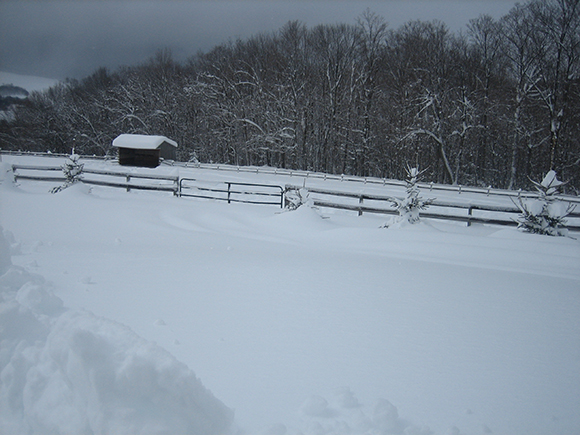
If you are using ice melt products other than sand ensure that they are a non-toxic variety. Some ice melt products are highly toxic to animals, and they can be tracked into stalls and over hay and ingested. While this is unlikely, it is much better to be safe than sorry. Some ice melt products will also crack concrete if left on the surface of the concrete for long periods. Read the product labels before you buy.
Barn Insulation
Insulating barns can be difficult because you don’t want to create a rodent zone in the walls or a vermin or bird hotel in the rafters. In our barn our roof is metal, and underneath the tin there is a sheathing of insulation board. This type of insulation prevents drips from condensation inside the building and adds a nice sound barrier too. Many companies use a double bubble wrap under the tin to lessen roof noise from heavy downpours and hail.
For wall insulation you can go with pumped in insulation or use traditional fiberglass batts. We recently had our landline phone in the office go dead and the telephone technician surmised it was due to mice chewing wires in the wall. The naughty rodents had obviously discovered our fiberglass insulation was the perfect nesting place. Thankfully we had a six pair telephone line coming into the building so we simply switched to another line. I was not looking forward to taking apart the beautifully finished wood wall. Due to the vermin issue the pumped in insulation that can be added to the building after construction, may be the better option than fiberglass batts.
Pumped in insulation comes in various forms of foam-like material. Some of these materials can be more eco-friendly than others. Cellulose for example has great insulating properties but may damage metal over time. Borate products used in cellulose foam production may also be toxic.
Cotton insulation comes in batts and is easy to install yourself, but is also processed with borates. It is fire resistant which is another factor to consider, and vermin don’t like it. Additionally it is not prone to mold which is a great advantage but it is also more expensive than cellulose. Whatever product you use, make sure that it is non-toxic if it is in an area that may be now, or become later, accessible to horses or other livestock. Also ensure it won’t damage the existing structure over time.
In our barn we did not insulate the stall walls. Horses like ventilation and we have no plans to heat the entire building. Us humans do retreat to the warmth of the tack room or office, during the coldest winter months throughout our workday, to warm up our fingers and toes.
We spoke with Jill Siragusa at the leading modular horse barn building company, Horizon Structures, to find out what their recommendations are for insulation.
“We typically advise our customers that insulation isn’t needed. We do ‘double bubble’ under metal roofing but that is generally more for sound insulation than heat or cold,’ explained Siragusa.
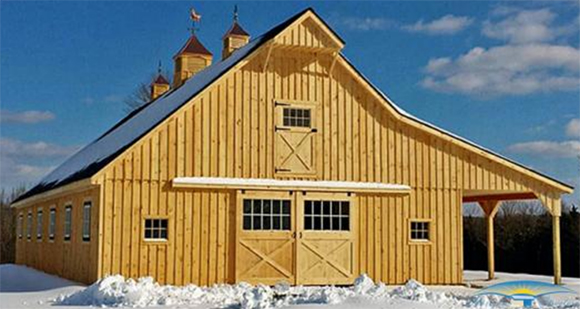
Indeed much has been written about horses and whether barns that are heated do more harm than good for an animal that likes to live outside. While that is a personal decision, and there are many factors to consider to decide what is best for your particular situation, it is true that horses do just fine without any additional heating in the building.
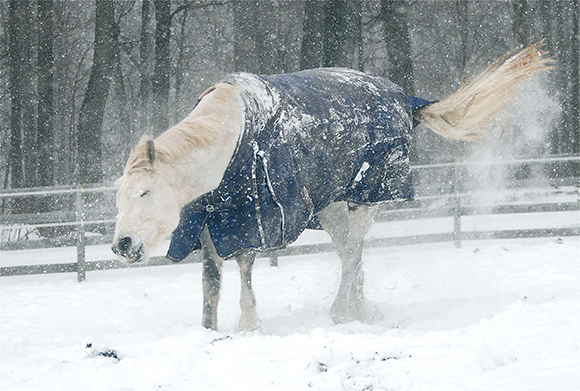
Water Welfare
Your pre-winter prep should include draining down any unprotected water lines that may freeze in winter. Wash stalls are often designed with water feed pipes running across the ceiling with drain taps at the end of downward runs, so they can be emptied of water utilizing Newton’s gravity at anytime, as the temperature decrees.
For your horses’ welfare their water supply should not be ice cold. Preferably some sort of water heater should keep the water above freezing so it doesn’t ice up. For water troughs some folks use empty water bottles, filled with a salt water blend and capped and float them in the water tank to keep the surface of the water from freezing. Unfortunately my horses think these water bottles are great fun and pull them out of the water and play about with them on the floor, so that isn’t an energy efficient option I can take advantage of and utilize.
You can plug in a tank heater at the base of the trough or float a tank heater in the water with the electrical cord protected from the horses’ reach by some sort of cover such as a sheath of plywood or Advantech. Some folks get creative and insulate the entire tank in a wood frame.
In the barn if you use insulated waterers or use any type of heating device to keep your buckets of water free of ice, check that there are no damaged wires, and that there is no electrical fire hazard. Any electrical cord should always be out of the reach of any inquiring animal snoot or teeth. If the water holds any type of electrical charge your horse probably will avoid it, but that creates a whole other problem. Check all heating equipment for damage regularly and watch your horses’ water intake at all times.
Empower Yourself
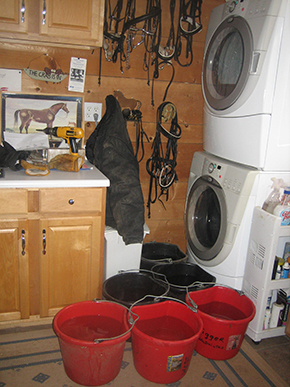 It is very important that you have a method for producing electricity in case of power outages. A small generator can service enough electricity to drive the pump to your well, or run a few light circuits. Keep your back up generator well-maintained and if it doesn’t have a cut off switch for fuel, empty all fuel after winter use. Ethanol in fuel will deteriorate seals in the fuel system otherwise.
It is very important that you have a method for producing electricity in case of power outages. A small generator can service enough electricity to drive the pump to your well, or run a few light circuits. Keep your back up generator well-maintained and if it doesn’t have a cut off switch for fuel, empty all fuel after winter use. Ethanol in fuel will deteriorate seals in the fuel system otherwise.
Even with a generator as back up, I still take precautions for water provision during winter storms. My tack room is well insulated and stays warm for a decent period of time even if the electric heat goes out, so I store extra buckets of water handy if we expecting a heavy hitting weather event. We also have a mobile water tank that we can load on a pick up or tractor and take to a water spring or water source elsewhere if necessary.
Fear of Fire
Removing cobwebs, cleaning fans, sweeping floors are just some of the important good housekeeping routines you should encompass in your cleaning program to increase the safety of your barn.
Safe hay storage practices are a must. You can learn about how to select the best hay and how to safely store it in this article. https://www.horizonstructures.com/blog/it’s-hay-season-are-you-playing-fire
Your fire safety routines should be established and implemented year round. One of the best resources I have found about fire safety is here http://www.omafra.gov.on.ca/english/engineer/facts/18-013.htm and I highly recommend you take the time to read it thoroughly and implement their suggestions.
Wherever you live, whether the winter is sunny and warm or cold and snowy, it is always good to be prepared. While we hope that this winter in the North-East is not as severe as last year, and keep our fingers crossed that our colleagues to the West receive the rain they need to put the fires out, one thing we all can count on is the ‘unpredictable nature of Mother Nature.’
I’m off to take my own advice and call my local gravel quarry and order a few truckloads of material. While hubbie moves the piles of gravel into the places where they are needed, I’ll be busy cleaning cobwebs down in the barn and window cleaning. There’s always something to do on a horse farm.
